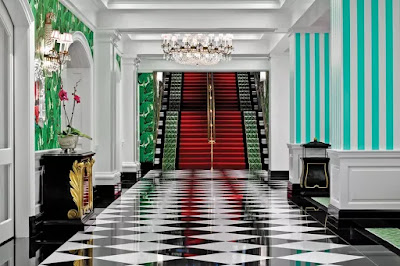Protomodernism is a design style that predicts the Modernism that is to come. It began in 1959 as yet another movement against the Victorian style, but it used different methods that were unlike the Arts and Crafts Movements or Art Nouveau. Protomodern designers rejected "ornamentation." And although they also used nature as an inspiration, they used forms that were more linear and geometric. In Europe, Germany and Austria were the key players in this movement. In German, there was the Deutscher Werkbund movement, and in Austria, the Vienna Secession.
The Deutcher Werkbund was a German association of designers and artists who embraced the use of the machine. Their goal was to produce high quality design with mass production. So, design professionals and product manufacturers collaborated to improve the German design. This movement inspired the early works of well known Modern designers Le Corbusier, Gropius, and Mies van der Rohe.
"To secede" means "to leave." The Vienna Secession was an Austrian design revolution where the members of the artistic community were fed up with Victorian historicism, so they withdrew from the academic institution to form their own group. The group favored the development of new, modern forms that had no ties to traditional design.
In America, Frank Lloyd Wright plays a key role with the "Prairie Style" design. This style integrates the materials, the structure, and the landscape harmoniously. He used glass to let the exterior natural world "come into" the building.
Interestingly, what gave protomodern artists such as Hoffmann, Klimt, and Wright their popularity is that one did not have to be a member of the "avant-garde" to appreciate their works. I like this because I believe that good design should be able to be appreciated by ordinary people, not just the "enlightened."
Historical Examples:
 |
Secession Building by Joseph Maria Olbrich
Vienna, Austria |
 |
Chairs designed by Josef Hoffmann 1905-1911
Palais Stoclet, Brussels. |
 |
Interior of Meyer House by Frank Lloyd Wright
Grand Rapids, MI |
 |
| Frank Lloyd Wright Barrel Chair |
Current Applications:
 |
Prairie House by Yunakov Architecture (2015) Kiev, Ukraine
Pays tribute to the famous Robie House by Wright (1909) |
 |
Interior of The Sunlight Residence from Proto Homes
Los Angeles, CA |
One Step Further...
Otto Wagner is an Austrian architect, urban planner, teacher, designer, and writer. He was born in Vienna, in 1841. He attended the Technical University in Vienna, where he studied arts and architecture. Then he went to Berlin and studied at Bauakademie, and then came back to Vienna to the Academy of Fine Arts.
He is a founder and leader of the modern movement in European architecture. In his works, he explored how to integrate decoration with underlying forms, and how they relate to programmatic function. One of his most impressive designs is the entrance to Karlsplatz Station, which he worked on with Olbrich. His urban projects were made of iron, stone, and brickwork.
He designed Postsparkasse (Post Office Savings Bank), Vienna with glass and aluminum. The banking hall is considered the first truly modern interior. The use of glass is a literal statement about financial transparency. One of his principles of design is for design to display an understanding of purpose, and to display good choices in materials.
 |
| Banking hall of Postsparkasse (1904-1906) by Otto Wagner |









Eunice, this a great summary and aa great reminder that Protomodernism's artists were inspired by nature, but they were also using geometric forms and new materials/ methods, which I think distinguishes them for the artists of the other two movements (Arts and Crafts and Art Nouveau).
ReplyDeleteMartha,
ReplyDeleteI appreciate how you said that anyone could enjoy art and design, not just the "enlightened." Your summary clearly portrayed the different movements and the many great designers that come from those movements. The banking hall of the Post Office designed by Wagner was also one of my favorites from this chapter; it is a big, open, and well-lit space.
Eunice,
ReplyDeleteVery nice detailed summary of Postmodernism. I appreciate your explanation of both the Duetcher Werkbund and the Vienna Succession. Your visual examples of this period are excellent.
Exploring Otto Wagner was an excellent choice. The Post Office Savings Bank is one of my favorite examples of interiors and furniture for this period.